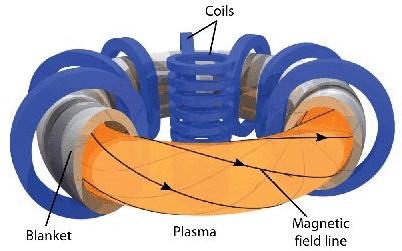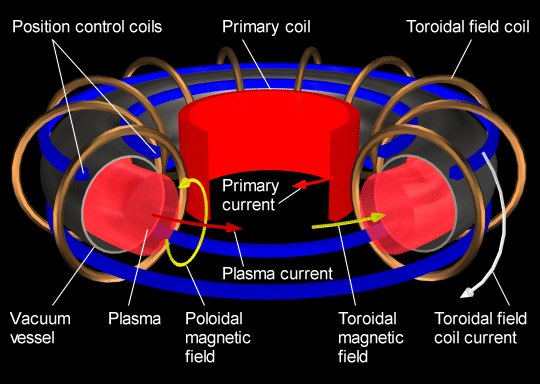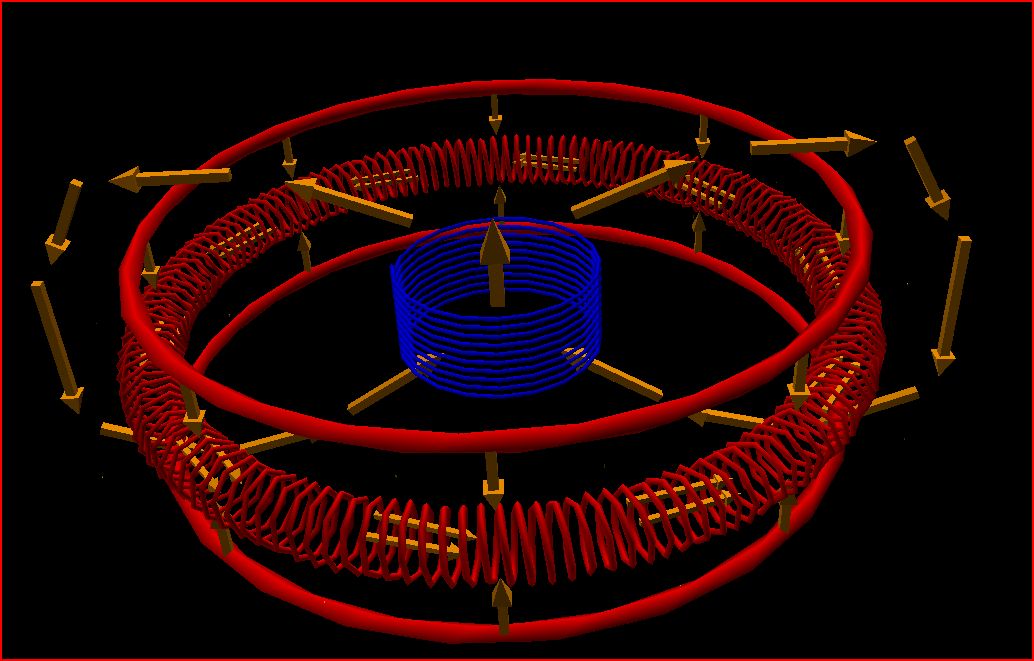Last edited 10dec09 by Matt Farrell
Find this document at http://new.math.uiuc.edu/math198/farrell1
Tokamak: Future of Nuclear Power
Abstract
Tokamaks are toroid shaped machines that take advantage of the relation between electricity and magnetism.
A magnetic field creates an electric field, while an electric current creates a magnetic field. A tokamak uses multiple
magnetic fields to influence the path of the plasma inside it.
Plasma
A plasma is the fourth state of matter. It is closest to a gas of the other three, but plasmas are ionized unlike
normal gasses. Being ionized means its particles all have either a positive or negative charge. This allows current to flow
through a plasma, so it can conduct electricity. In addition, this allows plasmas to respond to electromagnetic fields, which
is precisely how tokamaks confine them to a specific toroidal shape. In current tokamaks, the current is induced in the plasma
through a process known as ohmic heating. This uses the same idea as a transformer does, which is shown in the picture below.
 The inner loop in the python model represents the central loop acting as a transformer. As the current runs through the plasma, it also heats
it up due to the resistance of the particles present in the plasma. This current serves multiple purposes: heating up the plasma and also
inducing the current inside it so the plasma responds to electromagnetic fields.
The inner loop in the python model represents the central loop acting as a transformer. As the current runs through the plasma, it also heats
it up due to the resistance of the particles present in the plasma. This current serves multiple purposes: heating up the plasma and also
inducing the current inside it so the plasma responds to electromagnetic fields.
Additional Heating of Plasma
In order for fusion to occur, the plasma must be sufficiently large, and heated to temperatures of over 100 million degrees celsius. The ohmic heating
will only heat the plasma to less than a third of this requirement. Therefore, other measures are needed to heat the plasma to temperatures where fusion can occur.
A technique called neutral beam injection helps accomplish this. As the plasma is ionized, only neutral particles can be enter it without being affected by the
electromagnetic fields. As neutral particles are fired into the plasma, they collide with the already moving plasma particles, transfering their kinetic energy
to the plasma. As it is bombarded with neutral particles, the plasma begins to heat up as energy is transfered to it. Electromagnetic waves are another form of
transfering heat to the plasma. High frequency waves carry a high amount of energy. As high frequency waves are injected into the plasma, they collide with the plasma
particles and transfer their energy to the plasma, further increasing the temperature. Once a high enough temperature is reached, fusion can occur. This is because
a high enough temperature gives the particles enough energy to overcome the repulsive forces between the protons in their nuclei. This is a very strong repulsive force,
which is why such high temperatures are needed for the energy to overcome these forces.
Fusion and its results
Once fusion is reached and the plasma is successfully confined, the plasma will become self sufficient. This means
that no further energy needs to be added to the plasma, it can burn on its own and produce its own energy as long as more
fuel is added. The fuel commonly used are isotopes of hydrogen: deuterium and tritium. Hydrogen isotopes are used because
they are lighter than other elements. This means they have less protons in their nuclei, and thus have weaker repulsive forces to impede fusion. These isotopes
are generally easy to find throughout the Earth, and they are also cheap. This means that after fusion is reached, the power can be produced for little cost.
Power is produced through heating pads located on the walls of the tokamak. The products formed from fusion reactions will be neutral so they won't flow with the
rest of the plasma. According to iter.org, about 80% of the energy released from each fusion reaction will be present in the neutron produced in the reactions. This energy is present as kinetic energy, the neutrons will be moving very fast. As neutrons are neutral, they won't be controlled by the magnetic field like the rest of the ionized plasma. Due to this, the neutrons fly out of the plasma in their initial direction at a very fast speed. As these particles hit the walls of the tokamak, they transfer their kinetic energy to heating pads, causing their temperature to increase. Water pipes
are located directly next to the pads on the walls of the tokamak. As the pads heat up, the water is boiled and turned into steam. This steam then powers a turbine as is
the case in most standard power plants. Tokamaks currently require a lot more money up front to build than other power sources, however they are much cheaper and safter to
operate than most alternatives.
Confining the plasma
 The tokamak employs many magnetic fields to ensure the plasma stays tightly confined and away from its walls. The plasma must be dense for fusion to occur, but the temperature
of the plasma gets so high that anything it touches would melt instantly. This is why extremely strong magnets are needed to keep it away from the tokamak walls. Current tokamaks use two
magnetic fields, a poloidal and a toroidal one. The poloidal field is created from the transformer effect and the current in the plasma itself. This field causes the plasma particles to
spin in a helix pattern as it travels through the tokamak. This spinning keeps the particles constantly moving toward the center of the toroidal field and away from the walls. This picture
helps show this effect.
The tokamak employs many magnetic fields to ensure the plasma stays tightly confined and away from its walls. The plasma must be dense for fusion to occur, but the temperature
of the plasma gets so high that anything it touches would melt instantly. This is why extremely strong magnets are needed to keep it away from the tokamak walls. Current tokamaks use two
magnetic fields, a poloidal and a toroidal one. The poloidal field is created from the transformer effect and the current in the plasma itself. This field causes the plasma particles to
spin in a helix pattern as it travels through the tokamak. This spinning keeps the particles constantly moving toward the center of the toroidal field and away from the walls. This picture
helps show this effect.
 Magnets lining the walls of the toroid shaped tokamak produce the toroidal field. Magnets wrapped around the outside of the toroid vertically produce a field that travels
horizontally throughout the torus. This keeps the plasma flowing through the inside of the tokamak and keeps it away from the side walls because the field always points straight horizontally. Again,
the accompanying picture helps show this.
Magnets lining the walls of the toroid shaped tokamak produce the toroidal field. Magnets wrapped around the outside of the toroid vertically produce a field that travels
horizontally throughout the torus. This keeps the plasma flowing through the inside of the tokamak and keeps it away from the side walls because the field always points straight horizontally. Again,
the accompanying picture helps show this.

My project: Vpython model of magnetic fields
 My project is a model of the various magnetic fields created by magnets in a Tokamak. My model was made using Vpython and updating an existing toroidal model to make
it more accurate as a Tokamak rather than just a simple toroid. While the toroidal magnetic field is the most important concept in a Tokamak, it simply wouldn't function
without the other parts and their different resulting magnetic fields. The blue solenoid in the middle represents the central current used for inducing current in the plasma
and is also responsible for the ohmic heating of the plasma also. Sample magnetic field lines from the solenoid are shown with orange vectors. The red circles and central toroid
are models for the superconducting magnetics responsible for holding the plasma in place. Again, orange vectors represent the resulting magnetic forces from these magnets.
My project is a model of the various magnetic fields created by magnets in a Tokamak. My model was made using Vpython and updating an existing toroidal model to make
it more accurate as a Tokamak rather than just a simple toroid. While the toroidal magnetic field is the most important concept in a Tokamak, it simply wouldn't function
without the other parts and their different resulting magnetic fields. The blue solenoid in the middle represents the central current used for inducing current in the plasma
and is also responsible for the ohmic heating of the plasma also. Sample magnetic field lines from the solenoid are shown with orange vectors. The red circles and central toroid
are models for the superconducting magnetics responsible for holding the plasma in place. Again, orange vectors represent the resulting magnetic forces from these magnets.
 The inner loop in the python model represents the central loop acting as a transformer. As the current runs through the plasma, it also heats
it up due to the resistance of the particles present in the plasma. This current serves multiple purposes: heating up the plasma and also
inducing the current inside it so the plasma responds to electromagnetic fields.
The inner loop in the python model represents the central loop acting as a transformer. As the current runs through the plasma, it also heats
it up due to the resistance of the particles present in the plasma. This current serves multiple purposes: heating up the plasma and also
inducing the current inside it so the plasma responds to electromagnetic fields.
 The tokamak employs many magnetic fields to ensure the plasma stays tightly confined and away from its walls. The plasma must be dense for fusion to occur, but the temperature
of the plasma gets so high that anything it touches would melt instantly. This is why extremely strong magnets are needed to keep it away from the tokamak walls. Current tokamaks use two
magnetic fields, a poloidal and a toroidal one. The poloidal field is created from the transformer effect and the current in the plasma itself. This field causes the plasma particles to
spin in a helix pattern as it travels through the tokamak. This spinning keeps the particles constantly moving toward the center of the toroidal field and away from the walls. This picture
helps show this effect.
The tokamak employs many magnetic fields to ensure the plasma stays tightly confined and away from its walls. The plasma must be dense for fusion to occur, but the temperature
of the plasma gets so high that anything it touches would melt instantly. This is why extremely strong magnets are needed to keep it away from the tokamak walls. Current tokamaks use two
magnetic fields, a poloidal and a toroidal one. The poloidal field is created from the transformer effect and the current in the plasma itself. This field causes the plasma particles to
spin in a helix pattern as it travels through the tokamak. This spinning keeps the particles constantly moving toward the center of the toroidal field and away from the walls. This picture
helps show this effect.
 Magnets lining the walls of the toroid shaped tokamak produce the toroidal field. Magnets wrapped around the outside of the toroid vertically produce a field that travels
horizontally throughout the torus. This keeps the plasma flowing through the inside of the tokamak and keeps it away from the side walls because the field always points straight horizontally. Again,
the accompanying picture helps show this.
Magnets lining the walls of the toroid shaped tokamak produce the toroidal field. Magnets wrapped around the outside of the toroid vertically produce a field that travels
horizontally throughout the torus. This keeps the plasma flowing through the inside of the tokamak and keeps it away from the side walls because the field always points straight horizontally. Again,
the accompanying picture helps show this.
